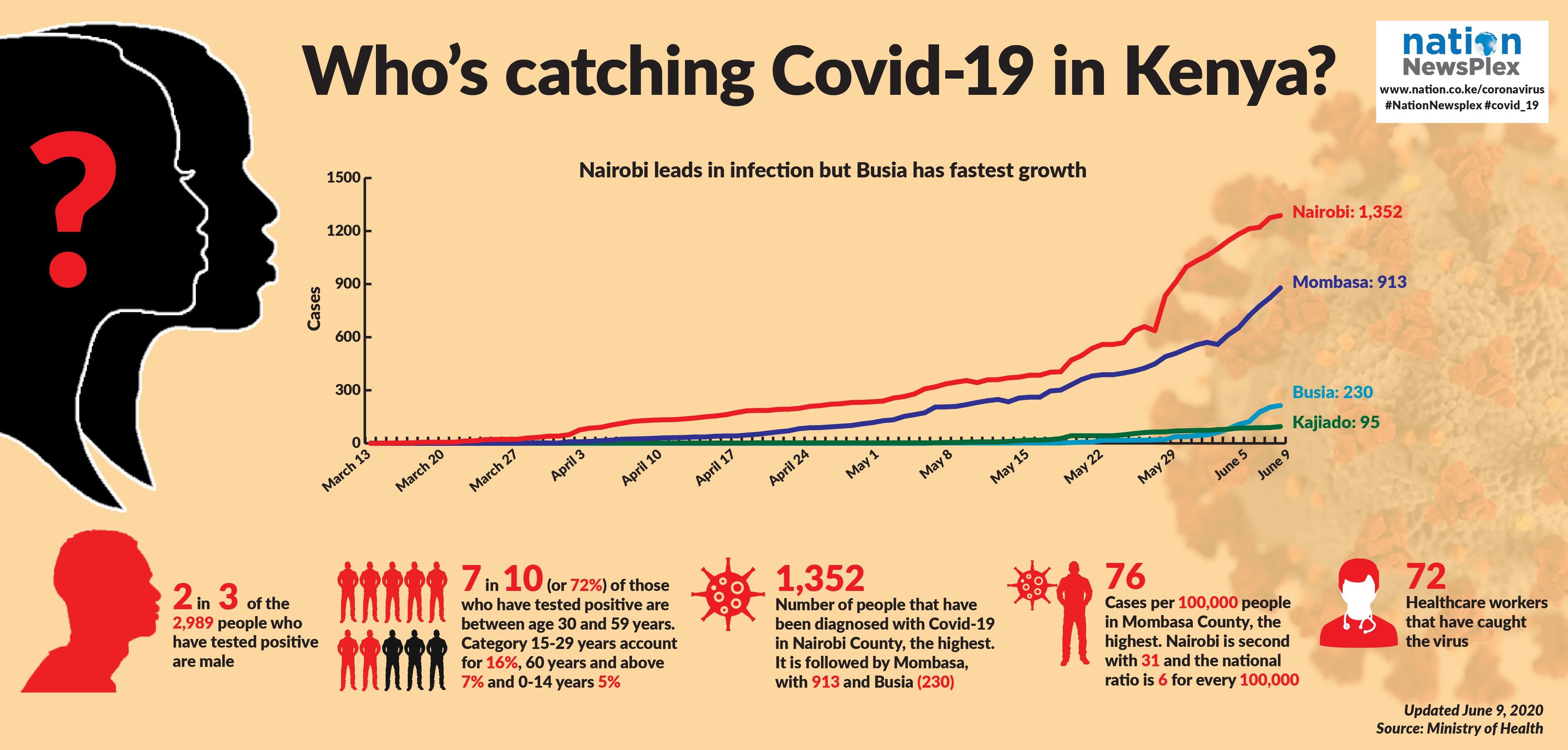Premium
Clean water a pipe dream for many
Kenya lost two in five litres of the piped water it produced last year, even as scarcity continues to bite, with the urban poor paying the highest price, reveals a NationNewsplex investigation.
The 90 billion litres lost annually, after allowing for the 20 percent acceptable loss, would adequately serve Nairobi County, with a daily demand of 750 million litres per day, for four months. If sold at a market value of Sh7 billion, the money could help to significantly improve the quality of services by water companies and boost water supply to consumers.
Fourteen counties lost more than a half of the water produced, up from 12 in the previous year, according to Impact: A Performance Report of Kenya’s Water Services Sector – 2017/18. Siaya lost the highest share (70 percent) and Makueni lost the least (29 percent).
The massive wastage, complemented by an extremely low investment in the sector, sets the country gravitating toward a crisis. The government invests only Sh40 billion annually against the Sh100 billion that the national water master plan recommends is needed to achieve universal access by 2030.
Most of the money goes towards the construction of dams but many of such projects have stalled and a couple are embroiled in a multi-billion-shilling scandal. This suggests that little of the allocated funds actually goes into improving the water situation in the country.
And the consequences are imposing – tap water was available to customers for only an average of 13 hours in 2017/18 financial year nationally, down from 14 hours the previous year and way below the acceptable sector benchmark of 16 hours, according to the report. Some regions had a much more depressed supply. Nairobi, the capital city and a regional economic hub, recorded a measly six hours of supply, one of the lowest in the country and the only one with under 10 hours among eight cities in East and Southern Africa.
While pumping the limited amount of water, companies generally give priority to strategic areas and customers such as the central business district, large academic institutions, military facilities, highly water-dependent factories and slums where acute shortage can easily spark an outbreak of attendant diseases like cholera. Water customers in or close to such areas are, therefore, cushioned from the extreme shortage that most areas experience.
“The Government must not only increase the allocation to water but there must be better efficiency in the use of funds and the water itself if we are to prevent the looming water crisis,” says Eng. Peter Njaggah, the director of technical services at the Water Services Regulatory Board (WASREB).
Like the rest of Africa, Kenya’s urban population is growing fast and will hit 22 million in 2030, according to the UN estimates. By 2050, towns and cities will account for more than half of the country’s population.
Paying the price
With the rapid urbanisation, those paying the highest price for the country’s diminishing capacity to provide adequate water are the people living in poor neighbourhoods but outside the category of slums, like Rhoda Atieno, a 41-year-old resident of Soweto-Kayole in Nairobi.
Monday 10am. The only water tap in the block shared by 11 households sticks out of the façade rather dully. Not a single drop since 5am when they started waiting. Water only flows on Mondays, and only for a few hours. That explains why close to a third of her seven square feet single-roomed house is packed to the ceiling with 20-litre jerry cans.
“If it gets to 11am before water flows, we usually look for other sources as we wait for Monday next week,” she says. After what seems like eternity, she withdraws her five jerry cans from the long queue, keeps four in the house and, with the remaining one in hand, asks me to follow her as she squeezes herself past the tiny gate.
There have been claims that persistent water shortage in some parts of urban areas is the work of cartels that thrive on scarcity and desperation.
We immediately plunge into a water carnival of sorts. The main street is a beautiful collage of water carts (mkokoteni), colourful jerry cans and multitudes pouring into the extravaganza or emptying into smaller alleys that lead them home. Every few minutes, a “clean water” truck slices through the crowd, puffing up curly blooms of smoke and dust.
But the spectacle created by the general view is suddenly lost the moment I lock my eyes on the hardship and toil firmly etched on the people’s faces.
“Water is one of the reasons we moved here in 2017 from Lunga lunga. Since there is a tap within this block, we thought we would be accessing water more easily, but we soon realised we were wrong,” Rhoda regrets. According to the Kenya Demographic and Health Survey (KDHS) 2014, nearly half (46 percent) of urban homes have piped water in dwellings, yards or plots. But such extreme cases of water rationing like in Rhoda’s case show that fewer connected households actually enjoy the service.
“New data linking water access to household wealth also shows that even in countries making progress, there are still vast discrepancies between richest and poorest,” states The Water Gap: The State of World’s Water 2018 report.
The government, through various agencies, has developed a number of policies to promote the enjoyment of the right to “clean and safe water in adequate quantities and to reasonable standards of sanitation” as stipulated in Article 43 of the Constitution. However, like many other rights that have been violated, the promise of clean and safe water has remained a pipe dream to many poor Kenyans.
There have been claims that persistent water shortage in some parts of urban areas is the work of cartels that thrive on scarcity and desperation. “Such cartels and brokers usually work in cahoots with members of a certain cadre of utility staff that, in most cases, act without the knowledge of senior management,” says Kariuki Mugo, the country manager at Water and Sanitation for the Urban Poor (WSUP), an organisation that has worked for 12 years with government institutions, service providers and communities to improve access to water in urban low income areas.
However, the Nairobi City Water and Sewerage Company (NCWSC) refutes such claims, with the acting managing director, Eng. Nahason Muguna, telling Newsplex that the water problem in Nairobi is purely as a result of demand exceeding supply.
In about 15 minutes, we get to the Soweto Social Hall where NCWSC sells water from a borehole, which, like all other boreholes in the area, produce salty water that cannot be used for drinking.
At Sh2 for every 20-litres, they, and a Catholic church not far away, offer the best price. There are a few other boreholes in the area, but they sell the same amount of water at Sh5. Their customers mainly include people who cannot walk for up to two kilometres to the points with the lowest prices and customers who need to fetch water before NCWSC and the church open, at 7am, or after they close, at 8pm. Those who want water delivered to their doorstep, such as the disabled and the sick who stay alone, or women who are pregnant or just delivered but have no care giver or house help, must pay Sh20 to mkokoteni vendors for 20 litre jerry can. This translates to a litre for a shilling. On the other hand, according to NCWSC tariffs, the utility delivers to customers within a certain proximity 8,000 litres in a tanker for Sh2,500, translating to 3.2 litres a shilling, which, because of economies of scale, is over three times cheaper than what the poor who cannot afford to buy and store in bulk pay water vendors for similar services.
Rhoda says that it is common knowledge in the neighbourhood that the extreme rationing is as a result of a collusion between private borehole owners, water transporters and certain people at NCWSC. “Whenever things attempt to get better, the mkokoteni people collect some money and give it to their connections at Nairobi Water and the taps go dry again,” she says.
According to Mr Mugo, whose organisation has footprints in several slums in Nairobi, Mombasa, Kisumu, Nakuru, Naivasha and Malindi, cartels only thrive in situations where water utilities have failed. “In this case you end up with two types of profiteers: those who will bring in water and sell it, and the ones that can build private boreholes,” he says, adding that cartels also vandalise the water infrastructure to sabotage it or engage in illegal connections.
Dropped points
The dwindling quality of service is not only a challenge in Nairobi. Some 43 out of the country’s 84 publicly-owned utilities dropped points in 2017/18 financial year over the previous years, according to the WASREB report. The companies were scored based on nine indicators, including water coverage, water quality, hours of supply and share of water lost (not billed).
Nyeri and Ruiru-Juja topped with 163 out of 200 points each followed by Murang’a, with 154 points. The bottom three were Homabay (15), Kapenguria (12) and Samburu (5).
It was the second year the regulator also conducted a special assessment on utilities’ performance in low income areas. Out of the 36 companies assessed, Nyeri came first with 91 percent, followed by Nakuru (80) and Nakuru Rural (79). At the bottom were Kirinyaga (29), Sibo (24) and Kahuti (21).





